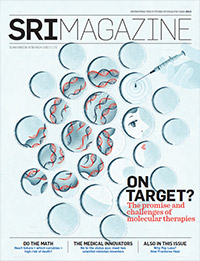Cover Slip

Image: taken with a Olympus FV1000MPE microscope. Adrienne Dorr, a research assistant in the lab of Dr. Bojana Stefanovic, acquired the image. The Canada Foundation for Innovation and Ontario Ministry of Research and Innovation provided funding for the microscope.
In addition to affecting neurons, or brain cells, most brain diseases, such as stroke and dementia, also cause injury to brain vessels.
Physicists and biologists at Sunnybrook Research Institute (SRI) are studying the mechanisms underlying changes in the structure and function of blood vessels in the brain following stroke or over the course of dementia, toward being able to understand these changes better, and, ultimately, translate that understanding into better care.
As part of this, they're using two-photon fluorescence microscopy. This noninvasive imaging technique allows an extremely detailed view of living brain tissue. With it, scientists can see into the working brain as much as one millimetre below the surface—very deep for brain imaging.
In this image, fluorescent dye is injected into the blood vessels of an adult mouse brain, allowing visualization of all vessels in a region of the neocortex that is one-half millimetre cubed—about the size of a needle's tip.



